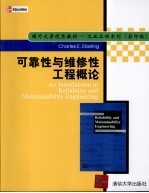图书介绍
可靠性与维修性工程概论 An Introduction to Reliability and Maintainaility Engineering 英文 engpdf电子书版本下载

- (美)埃贝灵(Ebeling,C.E.)著 著
- 出版社: 北京:清华大学出版社
- ISBN:9787302177548
- 出版时间:2008
- 标注页数:486页
- 文件大小:17MB
- 文件页数:502页
- 主题词:可靠性工程-高等学校-教材-英文
PDF下载
下载说明
可靠性与维修性工程概论 An Introduction to Reliability and Maintainaility Engineering 英文 engPDF格式电子书版下载
下载的文件为RAR压缩包。需要使用解压软件进行解压得到PDF格式图书。建议使用BT下载工具Free Download Manager进行下载,简称FDM(免费,没有广告,支持多平台)。本站资源全部打包为BT种子。所以需要使用专业的BT下载软件进行下载。如 BitComet qBittorrent uTorrent等BT下载工具。迅雷目前由于本站不是热门资源。不推荐使用!后期资源热门了。安装了迅雷也可以迅雷进行下载!
(文件页数 要大于 标注页数,上中下等多册电子书除外)
注意:本站所有压缩包均有解压码: 点击下载压缩包解压工具
图书目录
1Introduction 1
1.1 The Study of Reliability and Maintainability 3
1.2 Concepts,Terms,and Definitions 5
1.3 Applications 7
1.4 A Brief History 10
1.5 Scope ofthe Text 11
Appendix 1A A Probability Primet 13
PART 1 Basic Reliability Models 23
2The Failure Distribution 23
2.1 The Reliability Function 23
2.2 Mean Time to Failure 26
2.3 Hazard Rate Function 28
2.4 Bathtub Curve 31
2.5 Conditional Reliability 32
2.6 Summary 34
Appendix 2A Derivation of Equation(2.8) 35
Appendix 2B Derivation of Equation(2.12) 36
Appendix 2C Conditional Reliability and Failure Rates 36
Appendix 2D Intermediate Calculations for the Linear Bathtub Curve 37
Appendix 2E Table of Integrals 38
Exercises 38
3Constant Failure Rate Model 41
3.1 The Exponential Reliability Funcfion 41
3.2 Failure Modes 45
3.3 Applications 47
3.4 The Two-Parameter Exponential Distribufion 51
3.5 Poisson Process 52
3.6 Redundancy and the CFR Model 54
Exercises 55
4Time-Dependent Failure Models 58
4.1 The Weibull Distribution 58
4.2 The Normal Distribution 69
4.3 The Lognormal Distribution 73
Appendix 4A Derivation of the MTTF for the Weibull Distribution 77
Appendix 4B Derivation of the Mode for the Weibull Distribution 78
Appendix 4C Minimum Extreme-Value Distribution 78
Appendix 4D Hazard Rate for the Two-Component Weibull Redundant System 79
Exercises 79
5Reliability of Systems 83
5.1 Serial Configuration 83
5.2 Parallel Configuration 85
5.3 Combined Series-Parallel Systems 87
5.4 System Structure Function,Minimal Cuts,and Minimal Paths(Optional) 93
5.5 Common-Mode Failures 97
5.6 Three-State Devices 98
Exercises 102
6State-Dependent Systems 108
6.1 Markov Analysis 108
6.2 Load-Sharing System 111
6.3 Standby Systems 112
6.4 Degraded Systems 117
6.5 Three-State Devices 118
Appendix 6A Solution to Two-Component Redundant System 119
Appendix 6B Solution to Load-Sharing System 120
Appendix 6C Solution to Standby System Model 120
Exercises 121
7Physical Reliability Models 124
7.1 Covariate Models 124
7.2 Static Models 128
7.3 Dynamic Models 135
7.4 Physics-of-Failure Models 137
Exercises 141
8Design for Reliability 145
8.1 Reliability Specification and System Measurements 147
8.2 Reliability Allocation 151
8.3 Design Methods 157
8.4 Failure Analysis 166
8.5 System Safety and Fault Tree Analysis 172
Exercises 183
9Maintainability 189
9.1 Analysis of Downtime 189
9.2 The Repair-Time Distribution 191
9.3 Stochastic Point Processes 194
9.4 System Repair Time 202
9.5 Reliability under Preventive Maintenance 204
9.6 State-Dependent Systems with Repair 207
Appendix 9A The MTTF for the Preventive Maintenance Model 211
Appendix 9B Solution to the Active Redundant System with Repair 211
Appendix 9C Solution to Standby System with Repair 212
Exercises 213
10Design for Maintainability 218
10.1 Maintenance Requirements 219
10.2 Design Methods 225
10.3 Human Factors and Ergonomics 235
10.4 Maintenance and Spares Provisioning 237
10.5 Maintainability Prediction and Demonstration 244
Appendix 10A Birth-Death Queuing Model 248
Exercises 250
11Availability 254
11.1 Concepts and Definitions 254
11.2 Exponential Availability Model 257
11.3 System Availability 258
11.4 Inspection and Repair Availability Model 264
11.5 Design Trade-Off Analysis 266
Appendix 11A Solution to Single Unit with Repair Model 275
Exercises 275
PART 2 The Analysis of Failure Data 283
12Data Collection and Empirical Methods 283
12.1 Data Collection 283
12.2 Empirical Methods 286
12.3 Static Life Estimation 302
Exercises 303
13Reliability Testing 308
13.1 Product Testing 308
13.2 Reliabilitv Life Testing 309
13.3 Test Time Calculations 310
13.4 Burn-In Testing 312
13.5 Acceptance Testing 315
13.6 Accelerated Life Testing 323
13.7 Experimental Design 331
13.8 Competing Failure Modes 335
Appendix 13A Derivation of Expected Test Time 336
Appendix 13B Expected Test Time(Type II Testing) 337
Exercises 338
14Reliability Growth Testing 342
14.1 Reliability Growth Process 342
14.2 Idealized Growth Curve 343
14.3 Duane Growth Model 345
14.4 AMSAA Model 349
14.5 Other Growth Models 353
Exercises 355
15Identifying Failure and Repair Distributions 358
15.1 Identifying Candidate Distributions 359
15.2 Probability Plots and Least-Squares Curve-Fitting 362
15.3 Parameter Estimation 374
15.4 Confidence Intervals 382
15.5 Parameter Estimation for Covariate Models 385
Appendix 15A Weibull Maximum Likelihood Estimator 387
Appendix 15B Weibull MLE with Multiply Censored Data 388
Appendix 15C MLE for Normal and Lognormal Distributions with Censored Data 388
Exercises 389
16Goodness-of-Fit Tests 392
16.1 Chi-Square Goodness-of-Fit Test 393
16.2 Bartlett’s Test for the Exponential Distribution 399
16.3 Manns Test for the Weibull Distribution 400
16.4 Kolmogorov-Smirnov Test for Normal and Lognormal Distributions 402
16.5 Tests for the Power-Law Process Model 404
16.6 On Fitting Distribufions 407
Exercises 408
PART 3 Application 413
17Reliability Estimation and Application 413
17.1 Case 1:Redundancy 413
17.2 Case 2:Bum-In Testing 415
17.3 Case 3:Preventive Maintenance Analysis 418
17.4 Case 4:Reliability Allocation 421
17.5 Case 5:Reliability Growth Testing 423
17.6 Case 6:Repairable System Analysis 424
17.7 Case 7:Multiply Censored Data 426
Exercise 428
18Implementation 429
18.1 Obiectives,Functions,and Processes 429
18.2 The Economics of Reliability and Maintainability and System Design 430
18.3 Organizational Considerations 437
18.4 Data Sources and Data Collection Methods 439
18.5 Product Liability,Warranties,and Related Matters 445
18.6 Software Reliability 447
References 449
Appendix 455
Index 479